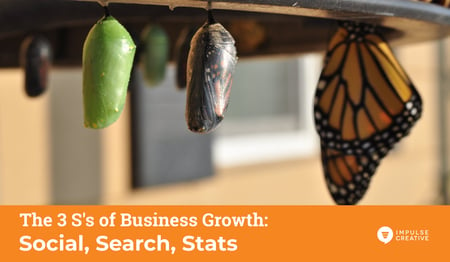Want to grow your business in 2020?

Seems like a no-brainer, right? The question is: How do you grow a business?
Since we’re a marketing and branding agency, we’ll concentrate our efforts there.
You could also look at cost cutting, increasing efficiencies, hiring and other areas. But we’ll look at increasing your audience and revenue.
If marketing is the art and science of starting the right conversation with the right people at the right time, then looking at the tools available to your business is where we’ll spend our time.
Marketing in today’s digital world will need to include social media, search engine optimization and marketing, as well as stats, analytics and dashboards.
Let’s start with the first S of 2020 business growth: Social.
How Does Social Media Help Businesses Grow?
Social media is the digital gathering place for all generations. No matter your demographic, they’re 99.9% sure to be on at least one social media platform with their family and friends.
Which means they’re also interacting with brands, even if they’re not aware of it.
If you’re not taking part in the conversations happening among your potential clients, you’re missing out.
Do you want to miss out?

Depending on your audience, you’ll want to explore the different social media platforms. You already know this, because you have a Facebook Business page, right?
Here’s a quick snapshot of the general social media platform demographics of the three top players according to Sprout Social:
- 2.2 billion monthly users, 1.5 billion check it daily
- 54% of users identify as female, 46% as male
- Age breakdown estimates—15% are 18-24 years old, 25% are 25-34, 20% are 35-44 15% are 45-54
- 80% of 18-49 year olds use Facebook
- 35% of all US adults use Instagram, 500 million daily users
- 72% of 13-17 year olds use Instagram, 64% of 18-29 year olds and 40% of 30-49 year olds
- Number one platform for B2B social media marketing
- About 600 million registered users
- 29% of 18-29 year olds use LinkedIn, 33% of 30-49 year olds and 24% of 50-64 year olds
- LinkedIn’s international presence is noteworthy with 70% of users residing outside of the US
Dive deeper into social media marketing with these two resources:
How Does Search Help Businesses Grow?
What’s the first thing we do today when we have a question or a problem to solve?
Once upon a time we’d ask an adult. Now the adult in the room is Google. Or Siri.

If you want someone to find your business, you need to be discoverable online. That’s the fundamental key to inbound marketing and content marketing.
In today’s business world, if someone can’t find you in search, it’s hard to say your business exists.
How do you get found by searchers? Search engine optimization (SEO), of course. It’s not breaking news, but it’s something that gets pushed off often enough that we’re still teaching business owners about it here at Impulse Creative.
A vital part of SEO is local search. Google My Business (GMB) has become an easy way for anyone searching online to find what they’re looking for without leaving the search engine results page (SERP).
Even if your business doesn’t only offer local solutions, like a restaurant or store, working on your GMB listing can help your business grow in 2020.
How to Create a Business Listing in Google
Head over to www.google.com/business/ and create an account. Make sure you—
- Click on “Get on Google.” Choose your Google business account email and sign in.
- Search for your business. It’ll ask you locate your business by name and address. If you can’t find it, simply click the option that says you don’t see a match and add your business. *If when you do see an existing listing, reference our “How to Claim a Business Listing” section below.
- Enter your location and business type. You’ll be given a few options to categorize your industry. It’s good practice to add at least three best matches related to your niche.
- Verify your business. Tell Google you are authorized to manage this business and click “Continue.” It’ll ask to verify your company address by snail-mailing a code. This takes a few days to arrive, but only a minute of your time to confirm later.
- Take a tour. Before using the dashboard, Google will ask you if you want to tour the platform. We recommend going along for the ride to ensure you learn the in’s and out’s.
- Set up your profile. This part isn’t hard to do. Just add your hours, phone number, pictures and more. Basically, include whatever possible to optimize your profile!
Once you create and optimize your Google Business listing, can help your company grow through inquiries.
Add to this an SEO strategy in your marketing—blogging, video, etc.— and you’ll see growth in the year to come.
How Do Stats Help Businesses Grow?
You can’t improve what you don’t measure. It’s that simple.

How do you know what to measure?
You have to start at the beginning of course. Metrics like website traffic are an important foundation. But it’s so much more than that. Create a dashboard that measures real conversions and you’ll have stats to help you improve in the year to come.
Here’s a look at a few marketing metrics to help your business grow better.
Visitor to Lead Conversion Rate
This metric helps you understand the earlier part of your customer’s journey. It’s the top of the funnel, or the early “awareness” stage of the buyer’s journey.
Visitors are great; but if they’re not taking the next step, it’s all in vain.
Ideally, we would like to see a visitor-to-lead conversion rate of 2% and above. Sometimes increasing your rate is as simple as adding calls to action (CTAs) to your homepage and blog articles. Other tips we offer include using smart content to speak directly to your ideal personas, using conversational marketing tactics like chatbots, adding video to your pages, and using a more active marketing voice.
Lead to MQL Conversion Rate
Once your website viewers become leads, what do they do? You should measure the rate at which they become ready for more marketing communications like regular emails.
The lead-to-marketing qualified lead (MQL) rate measures how successful the lower portion of your top-of-funnel efforts are working. Are your prospects just receiving a monthly newsletter and nothing else? Send helpful, engaging and powerful emails to guide them through the buying journey. Then measure the success.
Once someone gives you their email address, they aren't always ready for more marketing touches. So what do we suggest if that’s the case? Email nurturing, retargeting in social media and other awareness tactics can help. Your goal is to stay top of mind and begin to build trust.
We coach clients to strive for a conversion rate here of 30%. Anything above 10% is on the right track, though.
MQL to SQL Conversion Rate
Taking the step from marketing qualified lead to sales qualified lead begins with defining what sales needs from the lead. So, start with getting sales and marketing on the same page.
Once marketing knows what qualifies a lead for sales to pick up the baton, it’s a matter of adding content to guide the prospect from that middle of the funnel to the bottom. You want to help in this consideration stage with deeper content, trust-building information, and more.
Understanding how your conversion rate from MQL to SQL performs will help you see where you need to fill your content library. You might revisit a video marketing strategy, answering the questions your sales team consistently hears. This way you’re building confidence in your MQLs so they see no reason to avoid talking to your sales team. This moves them into the SQL range, allowing for your sales team to work their magic over time.
Work for a conversion rate here of more than 25%. We love to see clients with rates above 45%.
SQL to Opportunity Conversion Rate
As your sales team guides your prospects from their lead status into the opportunity stage, it’s all about measuring the signals. Are you paying attention to your prospects’ needs and their journey?
Opportunities are conversations. They are, in a way, the ideal sales qualified lead: your sales team has already conducted some initial outreach, and is beginning to nail down the details of a potential customer relationship or contract. So as you’re paying attention to those signals, you’re engaging in a conversation.
When you’re measuring - and working on - your SQL-to-opportunity conversion rate, you’re likely improving how your sales team speaks to their needs, how you communicate pricing and value, and the nurturing communication. You’re helping your prospects move from the know and like stages into trust.
At this point in the buyer’s journey, conversion rates should climb. We aim for at least 30% while really reaching for 45% and higher.
Opportunity to Customer Conversion Rate
This is where the rubber meets the road. One of the most important marketing metrics a conversion report needs to cover is the opportunity-to-customer conversion rate.
Once you know how your efforts pay off with customers, you’ll see the full picture of your marketing efforts, your investment in website and social media work, and everything else.
If you’re looking to improve this rate, things like sales training, high-quality case study stories, referral/testimonials and other tools can help.
An ideal conversion rate here looks like 33% and higher.
Ready to Grow in 2020?
When you’re ready to set your course for growth and build a successful marketing strategy, let us help get you pointed in the right direction. Our strategic roadmap will help you focus your efforts on scalable, achievable growth in the coming year.
Download the Strategic Marketing Roadmap today and get started planning your next 12 months of business growth.
Growth butterfly photo by Suzanne D. Williams on Unsplash





